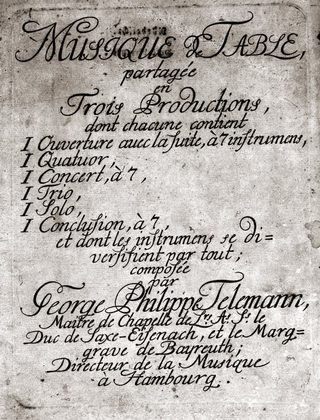
Georg Philipp Telemann was a German Baroque composer and multi-instrumentalist. He is one of the most prolific composers in history, at least in terms of surviving oeuvre. Telemann was considered by his contemporaries to be one of the leading German composers of the time, and he was compared favourably both to his friend Johann Sebastian Bach, who made Telemann the godfather and namesake of his son Carl Philipp Emanuel, and to George Frideric Handel, whom Telemann also knew personally.

The viola d'amore is a 7- or 6-stringed musical instrument with additional sympathetic strings used chiefly in the baroque period. It is played under the chin in the same manner as the violin.
The trio sonata is a genre, typically consisting of several movements, with two melody instruments and basso continuo. It originated in the early 17th century and was a favorite chamber ensemble combination in the Baroque era.

Trevor David Pinnock is a British harpsichordist and conductor.

Johann Friedrich Fasch was a German violinist and composer. Much of his music is in the Baroque-Classical transitional style known as galant.

Francesco Maria Veracini was an Italian composer and violinist, perhaps best known for his sets of violin sonatas. As a composer, according to Manfred Bukofzer, "His individual, if not subjective, style has no precedent in baroque music and clearly heralds the end of the entire era", while Luigi Torchi maintained that "he rescued the imperiled music of the eighteenth century", His contemporary, Charles Burney, held that "he had certainly a great share of whim and caprice, but he built his freaks on a good foundation, being an excellent contrapuntist". The asteroid 10875 Veracini was named after him.

The four orchestral suites BWV 1066–1069 are four suites by Johann Sebastian Bach from the years 1724–1731. The name ouverture refers only in part to the opening movement in the style of the French overture, in which a majestic opening section in relatively slow dotted-note rhythm in duple meter is followed by a fast fugal section, then rounded off with a short recapitulation of the opening music. More broadly, the term was used in Baroque Germany for a suite of dance-pieces in French Baroque style preceded by such an ouverture. This genre was extremely popular in Germany during Bach's day, and he showed far less interest in it than was usual: Robin Stowell writes that "Telemann's 135 surviving examples [represent] only a fraction of those he is known to have written"; Christoph Graupner left 85; and Johann Friedrich Fasch left almost 100. Bach did write several other ouverture (suites) for solo instruments, notably the Cello Suite no. 5, BWV 1011, which also exists in the autograph Lute Suite in G minor, BWV 995, the Keyboard Partita no. 4 in D, BWV 828, and the Overture in the French style, BWV 831 for keyboard. The two keyboard works are among the few Bach published, and he prepared the lute suite for a "Monsieur Schouster," presumably for a fee, so all three may attest to the form's popularity.
Winfried Michel is a German recorder player, composer, and editor of music.
Christoph Förster was a German composer of the baroque period.
Giovanni Benedetto Platti was born possibly 9 July 1697 in Padua, then belonging to Venice. He was an Italian Baroque composer and oboist. He died 11 January 1763 in Würzburg.

Johann Christian Schickhardt was a German composer and woodwind player.
Charles Dieupart was a French harpsichordist, violinist, and composer. Although he was known as Charles to his contemporaries according to some biographers, his real name was actually François. He was born in Paris, rue aux Ours, August 10th, 1676. His father was Nicolas Dieupart an ordinary musician to Louis XIV's Grande Ecurie. At some point, he befriended Elizabeth Wilmot of Rochester, countess of Sandwich, and Jacques Paisible who were visiting James II of England in his exile at Saint-germain-en-Laye near Paris. This is the main reason for his coming to London around 1700. A prominent member of the Drury Lane musical establishment, Dieupart was active both as composer and performer and actively participated in the musical life of the city. However, after about 1712 he earned his income mostly by teaching, and in his later years lived in poverty. He is best remembered today for a collection of six harpsichord suites which influenced Johann Sebastian Bach's English Suites.

The trumpet repertoire consists of solo literature and orchestral or, more commonly, band parts written for the trumpet. Tracings its origins to 1500 BC, the trumpet is a musical instrument with the highest register in the brass family.
The Telemann-Werke-Verzeichnis, abbreviated TWV, is the numbering system identifying compositions by Georg Philipp Telemann, published by musicologist Martin Ruhnke.

Tafelmusik is a collection of instrumental compositions by Georg Philipp Telemann (1681–1767), published in 1733. The original title is Musique de table. The work is one of Telemann's most widely known compositions; it is the climax and at the same time one of the last examples of courtly table music.
The bassoon repertoire consists of pieces of music composed for bassoon as a principal instrument that may be performed with or without other instruments. Below is a non-exhaustive list of major works for the bassoon.








